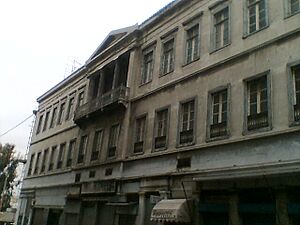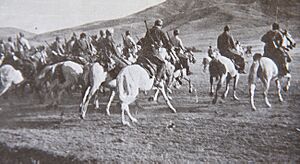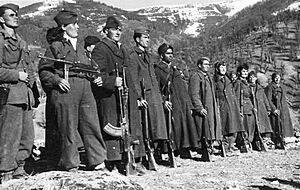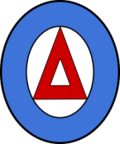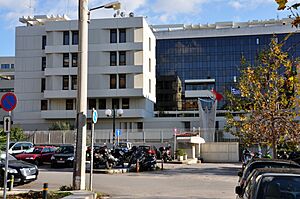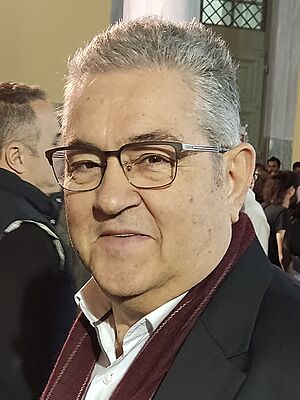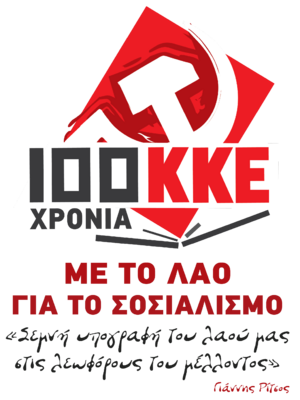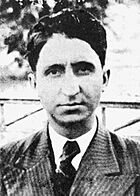Communist Party of Greece facts for kids
Quick facts for kids
Communist Party of Greece
Κομμουνιστικό Κόμμα Ελλάδας
|
|
|---|---|
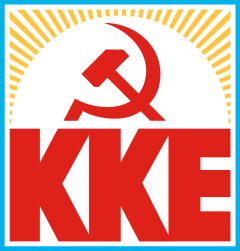 |
|
| Abbreviation | KKE |
| General Secretary | Dimitris Koutsoumpas |
| Founders | Demosthenes Ligdopoulos Stamatis Kokkinos Michael Sideris Nikos Demetratos Nikos Giannios Avraam Benaroya Michael Oikonomou Spyros Komiotis Giorgos Pispinis Aristos Arvanitis |
| Founded | 17 November [O.S. 4 November] 1918 as SEKE |
| Legalised | 1974 |
| Headquarters | 145 Leof. Irakliou, 142 31 Athens (Nea Ionia) |
| Newspaper | Rizospastis |
| Student wing | Panspoudastiki |
| Youth wing | Communist Youth of Greece |
| Trade union wing | All-Workers Militant Front |
| Ideology | Communism Marxism–Leninism |
| Political position | Far-left |
| European affiliation | INITIATIVE (2013–2023) ECA (2023–present) |
| International affiliation |
|
| European Parliament group | Non-Inscrits |
| Colours | Red |
| Slogan | Proletarians of all countries, unite (Προλετάριοι όλων των χωρών, ενωθείτε!) |
| Anthem | The Internationale |
| Parliament |
21 / 300
|
| European Parliament |
2 / 21
|
| Regional governors |
0 / 13
|
| Regional councillors |
46 / 611
|
| Mayors |
6 / 332
|
| Election symbol | |
 |
|
| Party flag | |
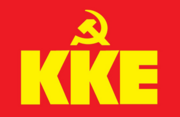 |
|
The Communist Party of Greece (Greek: Κομμουνιστικό Κόμμα Ελλάδας, Kommounistikó Kómma Elládas), often called KKE (pronounced "kay-kay-eh"), is a political party in Greece. It believes in Marxism–Leninism, which is a type of communism. The party started in 1918 as the Socialist Labour Party of Greece. It changed its name to KKE in 1924. It is the oldest political party in modern Greek history.
The KKE was banned in 1936. But it played a big part in the Greek resistance against invaders and in the Greek Civil War. Many people joined the party in the mid-1940s. The KKE became legal again in 1974 after a military government fell. Since then, the party has had members in the Greek Parliament. In 1989, it even joined a government for a short time.
Contents
History of the KKE
How the Party Started
The October Revolution in Russia in 1917 inspired many countries to start their own communist parties. The KKE was founded on November 4, 1918. Some of its founders were Aristos Arvanitis and Demosthenes Ligdopoulos. A small group of five people led the party at first.
Before the KKE, there were many small groups in Greece that believed in socialism and communism. These groups wanted to unite Greek workers. They also pushed for an eight-hour workday and better pay. The KKE was formed to bring these ideas together.
In April 1920, the KKE decided to join the Communist International (Comintern). This was a group of communist parties from around the world. The party then changed its name to the Socialist Labour Party of Greece-Communist (SEKE-K). In November 1924, it became the Communist Party of Greece (KKE). It also decided to follow the ideas of Marxism–Leninism.
Between the World Wars
The KKE did not support Greece's involvement in the Greco-Turkish War (1919–1922). They saw it as a war for control of land. KKE members spoke out against the war. They also worked with the Soviet Union to try and end the conflict.
The KKE was very active in organizing workers. They helped create trade unions and led strikes. They wanted better working conditions for everyone.
However, the Greek government did not like the KKE's activities. In 1929, a law called Idionymon was passed. This law made it easy to punish communists. Many KKE members were sent to prison or exiled. Despite this, the KKE continued to operate in major Greek cities.
The KKE also worked with other communist parties to fight against fascist movements in Europe. They created the People's Front in Greece. In 1936, the KKE was banned by the government. Many members were arrested or sent to isolated islands.
Some KKE members even went to Spain to fight in the Spanish Civil War (1936–1939). They joined groups like the International Brigades.
The Macedonian Issue
After several wars, Greece's borders were being discussed by powerful countries. There were many different groups of people living in Northern Greece. The KKE believed that these groups should have the right to decide their own future. This idea came from their Marxist–Leninist beliefs.
In 1924, the KKE supported the idea of "independent Macedonia and Thrace." This was the official view of the Comintern. Some people in Greece saw this as wanting to give away Greek land. This made the KKE less popular.
By 1934, the KKE changed its view. It said it would fight for self-determination within a "People's Republic." This meant that all groups would have their rights within one common state.
During the Greek Civil War, the KKE again talked about the "Macedonian Issue." They said the Macedonian people should have their own state within a family of free republics in the Balkans. However, in 1954, the KKE stopped supporting the idea of self-determination for minorities.
During World War II
1940: War Begins
By 1940, the KKE was in trouble. Many of its leaders were in prison. The police even created fake newspapers to confuse party members.
When Italy invaded Greece in October 1940, the KKE's leader, Nikos Zachariadis, who was in prison, wrote a letter. He said that Greeks should fight against Mussolini's fascism. He called for everyone to support the government in this national fight.
However, there was confusion. Some KKE members thought the war was just a fight between big powers. Zachariadis later changed his view in other letters. He said the Greek government was also an enemy. But after the war, he mostly talked about his first letter, showing the KKE's support for fighting the invaders.
On June 22, 1941, when Germany attacked the Soviet Union, the KKE told its members to fight against the fascist invaders.
1941: German Invasion and Resistance
Germany invaded Greece on April 6, 1941. Athens was taken on April 27. Many KKE members were already in prison. The new government handed some of them over to the Nazis. About 200 communists were executed by the Germans in 1944.
Despite the difficulties, KKE members stayed in touch. In July 1941, the KKE decided to start an armed fight against the invaders. They formed the first resistance groups in Macedonia and Thrace. These groups grew and attacked enemy positions.
On September 27, 1941, the KKE and other groups formed the National Liberation Front (EAM). They started forming armed groups of fighters.
1942 to Liberation
In February 1942, the Greek People's Liberation Army (ELAS) was formed. By 1943, it had 50,000 members. The KKE played a big role in organizing ELAS. The main goal was to free Greece from foreign powers.
ELAS sometimes fought with other resistance groups. These were the first signs of the coming Greek Civil War.
Nikos Zachariadis was held in a concentration camp during the war. He was released in 1945 and returned to lead the KKE.
KKE and the Greek Civil War
After Greece was freed from the Nazis in 1944, a new government was formed. The KKE and EAM controlled most of Greece. But the British and the new Greek government wanted ELAS to give up its weapons. This led to fighting in Athens in December 1944, known as the Dekemvriana.
After a ceasefire, ELAS gave up most of its weapons. But right-wing groups began to attack KKE members. Many KKE supporters went back to the mountains and formed small armed groups.
In 1946, these groups formed the Democratic Army of Greece (DSE). The KKE was the main political force behind the DSE. The Civil War (1946–1949) was fought between the DSE and the Greek government, which was supported by Britain and America.
In 1947, the KKE and its allies formed a temporary government. The KKE then became illegal. The Civil War ended in August 1949 with the defeat of the DSE.
After the War
After the Civil War, the KKE was banned. Many members had to leave Greece or go into hiding. Some KKE leaders were even executed. For many years, communists and their supporters faced discrimination in Greece. They couldn't work in public jobs. This changed when the KKE became legal again in 1974.
During the time it was illegal, the KKE supported another party called the United Democratic Left (EDA). EDA acted as the legal voice for the KKE.
During the Military Government
On April 21, 1967, a group of army officers took control of Greece. This was known as the Regime of the Colonels. All political parties were banned. KKE members were again targeted and arrested.
In 1968, the KKE faced a big split. Some members disagreed with the Soviet Union's actions in Czechoslovakia. This group left to form the Communist Party of Greece (Interior). This new party wanted a different approach to socialism.
Despite the split, the KKE continued to fight against the military government. They organized strikes and protests. Their youth group, the Communist Youth of Greece (KNE), worked secretly in universities.
Becoming Legal Again
In 1974, democracy returned to Greece. The KKE was made legal again. In the 1974 elections, the KKE joined with other parties and got 9.36% of the votes.
In 1989, the government officially recognized the Civil War. DSE fighters were no longer called "gangs."
Joining the Government
In 1944, the KKE was part of a national unity government for a short time. They held several important government positions.
In 1988, the KKE joined with other left-wing parties to form the Coalition of the Left and Progress (Synaspismos). In 1989, this group joined a government with another party. Later that year, Synaspismos was part of a "Universal Government." In 1991, the KKE left Synaspismos. Some KKE members stayed with Synaspismos, which later became part of the Coalition of the Radical Left.
The 21st Century
The KKE has been active in recent years. They took part in protests against government spending cuts in Greece starting in 2010. They also supported steel workers' strikes.
In the 2012 elections, the KKE gained more seats in parliament. But in the next election a month later, their support dropped. Since then, their support has slowly increased again. In the 2023 Greek election, the KKE won in the area of Icaria.
KKE's Policies
Economy
The KKE wants the government to own and control all major businesses and industries. They believe this would allow the economy to be planned to meet the needs of the Greek people.
Foreign Policy
The KKE does not support Greece being part of the European Union (EU). They believe Greece should leave the EU. They also strongly oppose Greece being in NATO.
The party sees China as a capitalist country, similar to the United States and the EU.
In 2022, the KKE spoke out against the war in Ukraine. They called it an "imperialist war." They also criticized both Russia's actions and the Ukrainian government.
In October 2023, the KKE supported Palestine and condemned Israel in the Israel–Hamas war.
Social Issues
In 2015, the KKE voted against a law that would allow civil partnerships for same-sex couples. They stated that marriage is for a man and a woman and is about having and raising children. They believe that a future socialist society would have a stable relationship between a man and a woman for reproduction.
In 2024, the party also voted against same-sex marriage in Greece.
Other Policies
The KKE supports keeping the church and state separate. However, people who are religious can still join the party.
Youth Group
The KKE has a youth organization called the Communist Youth of Greece (KNE). This group works closely with the KKE and supports its goals.
Splits and Alliances
Over the years, the KKE has had some groups split off.
- In 1956, a group called the Organisation of Marxists–Leninists of Greece (OMLE) formed.
- In 1968, a larger group split off to form the Communist Party of Greece (Interior).
- In 1988, the KKE joined with other parties to form the Coalition of the Left and Progress.
- Also in 1988, many members of the KKE's youth wing, KNE, left to form the New Left Current (NAR).
- In the early 2000s, some KKE officials left to form the Movement for the United in Action Left (KEDA). This group later joined the Coalition of the Radical Left.
What the KKE Does Today
The KKE is an important part of Greek politics. It has a lot of support among workers. The KKE has members in the Greek Parliament, local governments, and the European Parliament.
The KKE is also trying to connect with other communist groups around the world. They are discussing the future of communism in the 21st century. They are also looking at why the socialist systems in the Soviet Union and Eastern Europe ended.
The party publishes a daily newspaper called Rizospastis. It also has a political magazine called Komounistiki Epitheorisi and an education journal.
KKE Meetings (Congresses)
The KKE holds regular meetings called congresses to make important decisions.
- The 1st congress – November 1918, Piraeus
- The 2nd congress – April 1920, Athens
- The 3rd (extraordinary) congress – November–December 1924, Athens
- The 3rd (ordinary) congress – March 1927, Athens
- The 4th congress – December 1928, Athens
- The 5th congress – March 1934, Athens
- The 6th congress – December 1935, Athens
- The 7th congress – October 1945, Athens
- The 8th congress – August 1961 (secret meeting)
- The 9th congress – December 1973 (secret meeting)
- The 10th congress – May 1978
- The 11th congress – December 1982, Athens
- The 12th congress – May 1987
- The 13th congress – February 1991, Athens
- The 14th congress – December 1991, Athens
- The 15th congress – May 1996, Athens
- The 16th congress – December 2000, Athens
- The 17th congress – February 2005, Athens
- The 18th congress – February 2009, Athens
- The 19th congress – April 2013, Athens
- The 20th congress – March–April 2017, Athens
- The 21st congress – June 2021, Athens
KKE leaders also attended international meetings of communist parties in Moscow.
KKE Leaders
Here are the people who have led the KKE as First Secretary or General Secretary:
- Nikolaos Dimitratos (1918–1922)
- Yanis Kordatos (1922)
- Nikolaos Sargologos (1922–1923)
- Thomas Apostolidis (1923–1924)
- Pandelis Pouliopoulos (1924–1925)
- Eleftherios Stavridis (1925–1926)
- Pastias Giatsopoulos (1926–1927)
- Andronikos Chaitas (1927–1931)
- Nikos Zachariadis (1931–1936, first time)
- Andreas Tsipas (1941)
- Georgios Siantos (1942–1945, while Zachariadis was in prison)
- Nikos Zachariadis (1945–1956, second time)
- Apostolos Grozos (1956)
- Kostas Koligiannis (1956–1972)
- Charilaos Florakis (1972–1989)
- Grigoris Farakos (1989–1991)
- Aleka Papariga (1991–2013)
- Dimitris Koutsoumpas (2013–present)
Election Results
Greek Parliament Elections
| Election | Hellenic Parliament | Rank | Government | Leader | ||||
|---|---|---|---|---|---|---|---|---|
| Votes | % | ±pp | Seats won | +/− | ||||
| 1974 | With United Left |
5 / 300
|
4th | Opposition | Charilaos Florakis | |||
| 1977A | 480,272 | 9.4% | −0.1 |
11 / 300
|
4th | Opposition | ||
| 1981 | 620,302 | 10.9% | +1.5 |
13 / 300
|
3rd | Opposition | ||
| 1985 | 629,525 | 9.9% | −1.0 |
12 / 300
|
3rd | Opposition | ||
| June 1989 | With Synaspismos |
20 / 300
|
3rd | Interim government ND–SYN |
||||
| November 1989 |
16 / 300
|
3rd | National unity government ND–PASOK–SYN |
Grigoris Farakos | ||||
| 1990 |
15 / 300
|
3rd | Opposition | |||||
| 1993B | 313,001 | 4.5% | −5.7 |
9 / 300
|
4th | Opposition | Aleka Papariga | |
| 1996 | 380,046 | 5.6% | +1.1 |
11 / 300
|
3rd | Opposition | ||
| 2000 | 379,454 | 5.5% | −0.1 |
11 / 300
|
3rd | Opposition | ||
| 2004 | 436,818 | 5.9% | +0.4 |
12 / 300
|
3rd | Opposition | ||
| 2007 | 583,750 | 8.2% | +2.3 |
22 / 300
|
3rd | Opposition | ||
| 2009 | 517,154 | 7.5% | −0.7 |
21 / 300
|
3rd | Opposition | ||
| May 2012 | 536,105 | 8.5% | +1.0 |
26 / 300
|
5th | Snap election | ||
| Jun 2012 | 277,227 | 4.5% | −4.0 |
12 / 300
|
7th | Opposition | ||
| Jan 2015 | 338,138 | 5.5% | +1.0 |
15 / 300
|
5th | Opposition | Dimitris Koutsoumpas | |
| Sep 2015 | 301,632 | 5.6% | +0.1 |
15 / 300
|
5th | Opposition | ||
| 2019 | 299,592 | 5.3% | −0.3 |
15 / 300
|
4th | Opposition | ||
| May 2023 | 426,741 | 7.2% | +1.9 |
26 / 300
|
4th | Snap election | ||
| June 2023 | 401,187 | 7.7% | +0.5 |
21 / 300
|
4th | Opposition | ||
A 1977 results compared to the United Left totals in the 1974 election.
B 1993 results compared to the Synaspismos totals in the 1990 election.
European Parliament Elections
| European Parliament | |||||||
|---|---|---|---|---|---|---|---|
| Election | Votes | % | ±pp | Seats won | +/− | Rank | Leader |
| 1981 | 729,052 | 12.8% | New |
3 / 24
|
3rd | Charilaos Florakis | |
| 1984 | 693,304 | 11.6% | −1.2 |
3 / 24
|
±0 | 3rd | |
| 1989A | 936,175 | 14.3% | +2.7 |
4 / 24
|
3rd | ||
| 1994 | 410,741 | 6.3% | −8.0 |
2 / 25
|
4th | Aleka Papariga | |
| 1999 | 557,365 | 8.7% | +2.4 |
3 / 25
|
3rd | ||
| 2004 | 580,396 | 9.5% | +0.8 |
3 / 24
|
±0 | 3rd | |
| 2009 | 428,151 | 8.4% | −1.1 |
2 / 22
|
3rd | ||
| 2014 | 349,342 | 6.1% | −2.3 |
2 / 21
|
±0 | 6th | Dimitris Koutsoumpas |
| 2019 | 302,677 | 5.4% | −0.7 |
2 / 21
|
±0 | 4th | |
| 2024 | 367,796 | 9.2% | +3.8 |
2 / 21
|
±0 | 5th | |
A Contested as Coalition of the Left and Progress.
Party Members Over Time
| Membership (1918–1948) | ||||||||
|---|---|---|---|---|---|---|---|---|
| Year | Number of members | |||||||
| 1918 | 1,000 | |||||||
| 1920 | 1,320 | |||||||
| 1924 | 2,200 | |||||||
| 1926 | 2,500 | |||||||
| 1928 | 2,000 | |||||||
| 1930 | 1,500 | |||||||
| 1933 | 4,416 | |||||||
| 1934 | 6,000 (estimated) | |||||||
| 1936 (start) | 17,500 | |||||||
| 1936 (middle) | <10,000 (estimated) | |||||||
| 1941 | 200 (estimated) free + 2,000 in prison | |||||||
| 1942 (December) | 15,000 | |||||||
| 1944 (June) | 250,000 | |||||||
| 1944 (October) | 420,000–450,000 | |||||||
| 1945 (October) | 45,000 | |||||||
| 1946 (February) | <100,000 | |||||||
| 1948 | <50,000 | |||||||
See also
 In Spanish: Partido Comunista de Grecia para niños
In Spanish: Partido Comunista de Grecia para niños
- All-Workers Militant Front (PAME)
- International Meeting of Communist and Workers' Parties
- Initiative of Communist and Workers' Parties
- Socialism in Greece



